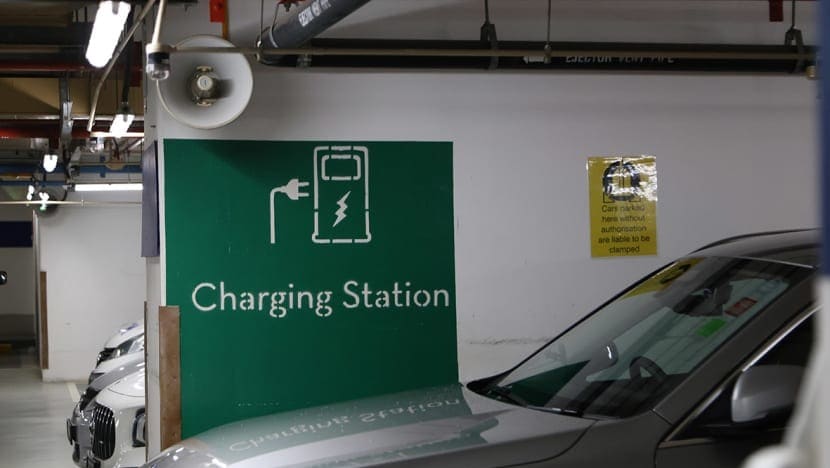Why are COE premiums increasing despite supply boost, and could this persist?
Despite increasing supply, the popularity of Chinese electric vehicles and growing affluence among Singapore residents may keep COE prices elevated for years.

An electric vehicle (EV) charging station. (Photo: TODAY/Raj Nadarajan)

This audio is generated by an AI tool.
SINGAPORE: The growing popularity of mass market Chinese electric vehicles (EVs), combined with increasing household incomes, could explain the highest Certificate of Entitlement (COE) premiums for cars in almost two years, experts said.
One analyst said that the market has not reached peak COE supply, and that prices will likely drop only towards the end of the decade.
Category A premiums rose to S$104,524 (US$81,300) in the latest bidding exercise on Wednesday (Aug 20), approaching the all-time high of S$106,000 recorded in October 2023.
Prices for larger cars in Category B reached S$124,400, the highest since December 2023, while Open Category COEs climbed to S$125,001.
Analysts had earlier projected that premiums could start falling from 2024 due to the 10-year cycle of COE supply, which had been increasing since 2014.
WHY ARE COE PREMIUMS STILL INCHING HIGHER?
One reason for the sustained high premiums is the influx of mass market Chinese EVs, said Associate Professor Walter Theseira from the Singapore University of Social Sciences.
He noted that these vehicles offer “excellent value” due to lower import costs and high build quality, while subsidies like the EV Early Adoption Incentive and the Vehicular Emissions Scheme rebate – which can shave up to S$40,000 off upfront costs – further spur demand.
“This is likely a contributing factor to higher COE premiums in recent months,” said Assoc Prof Theseira.
Agreeing, transport analyst Terence Fan said that subsidies and the lower prices of EV cars soften the blow of high COE prices.
“Motorists dive in thinking they save some on the car, and pay more for the COEs, and they think that’s okay,” said Assistant Professor Fan, from the Singapore Management University.
Assoc Prof Theseira added that with incentives set to end this year, prices could moderate.
Rising household incomes and economic optimism are also driving car purchases, said Dr Fan. While concerns about global trade due to the US tariffs cast a shadow earlier this year, it has become apparent that “the world hasn’t fallen apart”.
“Singapore registered gains in its GDP, so some of these gains are going to translate into people’s income and the outlook at how (the economy) is going to be,” he said.
If residents here are “buoyant at the prospects” they will continue to make purchases such as for cars, said Dr Fan.
WHY HASN’T SUPPLY CAUGHT UP TO DEMAND?
Still, some may wonder why the rising supply of COEs has not yet eased premiums. Assoc Prof Theseira explained that while supply has been growing, it remains well below historical peaks.
COE supply began to rise in 2014 but did so from a low base. From February 2013 to April 2014, fewer than 400 COEs were available in Category A in each bidding exercise.
The COE quota then began steadily increasing, surpassing 1,400 in Category A in May 2015. For the next four years after, the supply remained relatively high at above 1,000 in each bidding exercise.
COE quotas have increased steadily in the past few years. In 2022 and 2023, COE quotas for Category A did not surpass 1,000 in any given bidding exercise, but went across that figure in 2024, and has stayed above 1,000 so far in 2025.
“Although COE quota supply has risen significantly over the last year, it is still quite far below the peak supply years,” said Assoc Prof Theseira.
He said that it typically takes a few years of increasing supply for prices to fall.
For instance, while 2014 was when COE quota supply began to increase, it was only “much later” in 2016 and 2017 that the supply “went up”. It was in 2016 that there was a peak quota supply of 2,272 for one bidding exercise for that 10-year cycle.
Assoc Prof Theseira added that this 10-year cycle is not “perfect”, as some cars are deregistered early, and others are renewed and may be deregistered at any time.
WERE CUT-AND-FILL, COE INJECTIONS EFFECTIVE?
Analysts say that measures such as the cut-and-fill strategy and the injection of up to 20,000 COEs were aimed more at stabilising prices than reducing them.
The cut-and-fill strategy ensures COE quota supply can be brought forward from peak years to fill the current supply troughs while maintaining a zero-vehicle growth policy.
This helps to ensure that there are no large fluctuations in COE prices, said Associate Professor Raymond Ong from the National University of Singapore.
“If let’s say (the government) doesn’t do cut and fill, what happens as in past few cycles, or even in this year’s cycle, we will see a much reduced supply for COEs, which means there is an uncontrolled variation that is very likely to happen in the COE prices,” said Assoc Prof Ong, who is the associate head of research at NUS' Department of Civil and Environmental Engineering.
“It’s this uncontrolled variation that we don’t want to see,” he added.
He noted that though COE premiums inched higher, they have remained relatively stable over the past months.
Since the start of the year, Category A premiums have been between S$85,000 and S$104,524, while Category B premiums between S$109,598 and S$124,400.
Agreeing, Assoc Prof Theseira said that the cut-and-fill method was designed to address the fundamental imbalances between COE supply across years where “buyers in some years pay tens of thousands, maybe even a hundred thousand, more than buyers in other years”.
As for the injection of 20,000 COEs, Assistant Professor Lee Kwok Hao said that the additional supply would have put premiums “on a lower trajectory than without them”.
However, the impact on lowering premiums is limited, as the 20,000 COEs only make up a small 2 per cent proportion of the vehicle population, said Dr Lee, who is from the Department of Strategy and Policy at the NUS Business School.
“Introduced over several years, I expect their impact on prices to be small relative to the secular impact of continued strong demand,” he said.
Former Transport Minister Chee Hong Tat said last year that more of such injections can be considered if distance based charging under the ERP 2.0 system is implemented.
WHEN WILL COE PREMIUMS FALL?
Analysts were divided about whether COE premiums will fall significantly in the coming years.
Assoc Prof Theseira believes that the 10-year cycle will eventually lead to a dip in prices towards the end of the decade, similar to the trend in the 2010s.
Periods of high supply are usually a “self-reinforcing” concept, he added. This is because car owners try to “time” when to scrap their car, and when COE prices are low, owners are more likely to deregister their cars early.
When many do this at the same time, it creates a surge of COEs, which keeps prices low. He expects this to occur in the late 2020s.
“Thus, for car buyers who can wait, (such as those whose) current COE doesn't expire for another few years, I would still recommend waiting,” he said.
However, other analysts were more cautious. Assoc Prof Ong said that with rising incomes, more people are likely to enter the car market.
“The increased demand is unlikely to result in drop of price in the near term,” he said.
Dr Lee said: “If the current zero vehicle growth regime continues, given anticipated population growth, we should see prices continue to rise gradually.”










.jpg?itok=4eKODDry)









